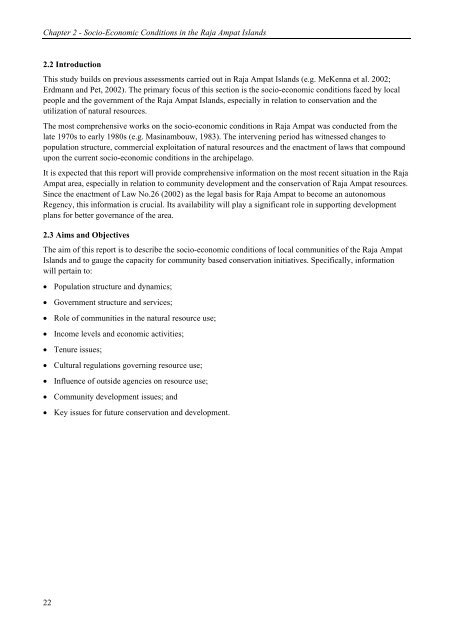- Page 1: FINAL DRAFT Report on a rapid ecolo
- Page 5 and 6: Table of contents Acknowledgements
- Page 7 and 8: 3.10 References ...................
- Page 9: Appendix 8. List of participants of
- Page 13 and 14: Chapter 1 Executive Summary 1.1 Int
- Page 15 and 16: Chapter 1 - Executive Summary landi
- Page 17 and 18: Chapter 1 - Executive Summary Table
- Page 19 and 20: Chapter 1 - Executive Summary colle
- Page 21 and 22: Chapter 1 - Executive Summary Grass
- Page 23 and 24: Chapter 1 - Executive Summary plus
- Page 25: Chapter 2 Socio-Economic Conditions
- Page 29 and 30: Chapter 2 - Socio-Economic Conditio
- Page 31 and 32: Chapter 2 - Socio-Economic Conditio
- Page 33 and 34: Chapter 2 - Socio-Economic Conditio
- Page 35 and 36: Chapter 2 - Socio-Economic Conditio
- Page 37 and 38: Chapter 2 - Socio-Economic Conditio
- Page 39 and 40: Chapter 2 - Socio-Economic Conditio
- Page 41 and 42: Chapter 2 - Socio-Economic Conditio
- Page 43 and 44: Chapter 2 - Socio-Economic Conditio
- Page 45 and 46: Chapter 2 - Socio-Economic Conditio
- Page 47 and 48: Chapter 3 - Coral Reef Fishes of th
- Page 49 and 50: Chapter 3 - Coral Reef Fishes of th
- Page 51 and 52: Chapter 3 - Coral Reef Fishes of th
- Page 53 and 54: Chapter 3 - Coral Reef Fishes of th
- Page 55 and 56: Chapter 3 - Coral Reef Fishes of th
- Page 57 and 58: Chapter 3 - Coral Reef Fishes of th
- Page 59 and 60: Chapter 3 - Coral Reef Fishes of th
- Page 61 and 62: Chapter 3 - Coral Reef Fishes of th
- Page 63 and 64: Chapter 4 Coral Diversity and the S
- Page 65 and 66: Chapter 4 - Coral Diversity and the
- Page 67 and 68: Chapter 4 - Coral Diversity and the
- Page 69 and 70: Chapter 4 - Coral Diversity and the
- Page 71 and 72: Chapter 4 - Coral Diversity and the
- Page 73 and 74: Chapter 4 - Coral Diversity and the
- Page 75 and 76: Chapter 4 - Coral Diversity and the
- Page 77 and 78:
Chapter 4 - Coral Diversity and the
- Page 79 and 80:
Chapter 4 - Coral Diversity and the
- Page 81 and 82:
Chapter 4 - Coral Diversity and the
- Page 83 and 84:
Chapter 4 - Coral Diversity and the
- Page 85 and 86:
Chapter 4 - Coral Diversity and the
- Page 87 and 88:
Chapter 4 - Coral Diversity and the
- Page 89 and 90:
Chapter 5 Status of Sea Turtle Popu
- Page 91 and 92:
Chapter 5 - Status of Sea Turtle Po
- Page 93 and 94:
Chapter 5 - Status of Sea Turtle Po
- Page 95 and 96:
Chapter 5 - Status of Sea Turtle Po
- Page 97 and 98:
Chapter 5 - Status of Sea Turtle Po
- Page 99 and 100:
Chapter 5 - Status of Sea Turtle Po
- Page 101 and 102:
Chapter 6 An Ecological Summary of
- Page 103 and 104:
Chapter 6 - An Ecological Summary o
- Page 105 and 106:
Chapter 6 - An Ecological Summary o
- Page 107 and 108:
Chapter 6 - An Ecological Summary o
- Page 109 and 110:
Chapter 6 - An Ecological Summary o
- Page 111 and 112:
Chapter 6 - An Ecological Summary o
- Page 113 and 114:
Chapter 6 - An Ecological Summary o
- Page 115 and 116:
Chapter 6 - An Ecological Summary o
- Page 117 and 118:
Chapter 6 - An Ecological Summary o
- Page 119 and 120:
Chapter 6 - An Ecological Summary o
- Page 121 and 122:
Chapter 6 - An Ecological Summary o
- Page 123 and 124:
Chapter 6 - An Ecological Summary o
- Page 125 and 126:
Chapter 6 - An Ecological Summary o
- Page 127 and 128:
Chapter 6 - An Ecological Summary o
- Page 129 and 130:
Chapter 6 - An Ecological Summary o
- Page 131 and 132:
Chapter 6 - An Ecological Summary o
- Page 133 and 134:
Chapter 6 - An Ecological Summary o
- Page 135 and 136:
Chapter 6 - An Ecological Summary o
- Page 137 and 138:
Chapter 6 - An Ecological Summary o
- Page 139 and 140:
Chapter 6 - An Ecological Summary o
- Page 141 and 142:
Chapter 6 - An Ecological Summary o
- Page 143 and 144:
Chapter 6 - An Ecological Summary o
- Page 145 and 146:
Chapter 6 - An Ecological Summary o
- Page 147 and 148:
Chapter 6 - An Ecological Summary o
- Page 149 and 150:
Chapter 6 - An Ecological Summary o
- Page 151 and 152:
Chapter 7 Extension Workshop on the
- Page 153 and 154:
Chapter 7 - Extension Workshop on t
- Page 155 and 156:
Chapter 7 - Extension Workshop on t
- Page 157 and 158:
Chapter 7 - Extension Workshop on t
- Page 159 and 160:
Appendices 155
- Page 161 and 162:
SPECIES SITE RECORDS ABUNDANCE OREC
- Page 163 and 164:
Appendices SPECIES SITE RECORDS ABU
- Page 165 and 166:
Appendices SPECIES SITE RECORDS ABU
- Page 167 and 168:
Appendices SPECIES SITE RECORDS ABU
- Page 169 and 170:
Appendices SPECIES SITE RECORDS ABU
- Page 171 and 172:
Appendices SPECIES SITE RECORDS ABU
- Page 173 and 174:
Appendices SPECIES SITE RECORDS ABU
- Page 175 and 176:
Appendices SPECIES SITE RECORDS ABU
- Page 177 and 178:
Appendices SPECIES SITE RECORDS ABU
- Page 179 and 180:
Appendices SPECIES SITE RECORDS ABU
- Page 181 and 182:
Appendices SPECIES SITE RECORDS ABU
- Page 183 and 184:
Appendices SPECIES SITE RECORDS ABU
- Page 185 and 186:
Appendices SPECIES SITE RECORDS ABU
- Page 187 and 188:
Appendices SPECIES SITE RECORDS ABU
- Page 189 and 190:
Appendices SPECIES SITE RECORDS ABU
- Page 191 and 192:
Appendices Appendix 2. Full list of
- Page 193 and 194:
1 2 3 4 5 6 7 8 9 10 11 12 13 14 15
- Page 195 and 196:
1 2 3 4 5 6 7 8 9 10 11 12 13 14 15
- Page 197 and 198:
1 2 3 4 5 6 7 8 9 10 11 12 13 14 15
- Page 199 and 200:
1 2 3 4 5 6 7 8 9 10 11 12 13 14 15
- Page 201 and 202:
1 2 3 4 5 6 7 8 9 10 11 12 13 14 15
- Page 203 and 204:
1 2 3 4 5 6 7 8 9 10 11 12 13 14 15
- Page 205 and 206:
Appendices Appendix 3A. Biological
- Page 207 and 208:
Appendices Appendix 3B. Reef charac
- Page 209 and 210:
Appendices Appendix 4. Full list of
- Page 211 and 212:
Appendices Zooxanthellate Scleracti
- Page 213 and 214:
Appendices Zooxanthellate Scleracti
- Page 215 and 216:
Appendices Zooxanthellate Scleracti
- Page 217 and 218:
Appendices Zooxanthellate Scleracti
- Page 219 and 220:
Appendices Zooxanthellate Scleracti
- Page 221 and 222:
Appendices Zooxanthellate Scleracti
- Page 223 and 224:
Appendices Zooxanthellate Scleracti
- Page 225 and 226:
Appendices Appendix 5. Other non-zo
- Page 227 and 228:
% % % % %%% %% % % % %% %% % %% %%%
- Page 229 and 230:
% % % % %%% %% % % % %% %% % %% %%%
- Page 231 and 232:
% % % % %%% %% % % % %% %% % %% %%%
- Page 233 and 234:
Appendices 229
- Page 235 and 236:
Appendices 231
- Page 237 and 238:
Appendices Appendix 9. Transcripts
- Page 239 and 240:
Appendices Group 3 Threats (land):
- Page 241 and 242:
Appendices Group 4 Threats Actions
- Page 243 and 244:
Appendices Group 6 Threats (land):
- Page 245 and 246:
Appendices Group 8 Threats 1. Fish
- Page 247 and 248:
Appendices specifically to TNC and
- Page 249 and 250:
Appendices • Relevant tropical ma





